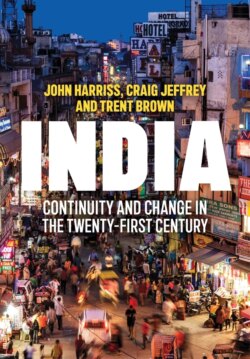Читать книгу India - Craig Jeffrey - Страница 28
2.6 Conclusion
ОглавлениеFor the first three decades following independence in 1947, India experienced highly variable economic growth rates, but averaging less than 4 per cent per annum. This period of the ‘licence-permit-quota raj’ saw bureaucrats holding important discretionary powers, and these helped to give rise to what Kar and Sen describe as a disordered deals environment, not conducive to growth. Though sometimes written off, this period was not wholly unsuccessful. The industrial structure of the country was transformed in a remarkably short period of time, and skills were built up that have served the Indian economy very well in more recent years. Yet decisions taken in this period, or decisions not taken, or failures of policy implementation have had highly significant consequences over the longer run. Governments failed to tackle the problem of improving the productivity of Indian agriculture (on which, see chapter 4), except by means of a regime of subsidies that have tended to benefit larger farmers only in certain parts of the country – Punjab, Haryana, western UP and coastal Andhra Pradesh in particular. The country became set on a path of industrial development that was not based on labour-intensive manufacturing of products for export; and set, too, on a path that protected manufacturing of many products in small-scale units, with the result that there are relatively very few middle-sized establishments in Indian industry. There is a ‘missing middle’.
Economic growth picked up significantly from the early 1980s – or the later 1970s according to Sen – partly because of a more positive attitude towards private business on the part of the political elite. This evidently helped to stimulate private investment in the 1980s, especially in equipment, drawing on improvement in the savings rate in the 1970s with the financial deepening that took place in those years. Then in 1991, in the context of a liquidity crisis, a tipping point was reached, and the long-standing advice of liberal economists at last was accepted by policy makers. India undertook what were described as ‘economic reforms’ and started on a path of deregulation and liberalization that brought the ‘licence-permit-quota raj’ to an end. The discretionary powers of bureaucrats were reduced, if not eliminated – collusive relations remained, between some big business groups and political and bureaucratic elites. But as Kar and Sen describe it, the deals environment became both more open, and more ordered, with a positive impact on rates of growth, which now became much less variable.
Then, at last, India attained more or less ‘superfast’ growth for about five years from 2003–04. The cumulative effects of the economic reforms were reflected in the rise of corporate savings and investment in this time, and in marked improvement in productivity. Yet, according to the analysis by Kar and Sen, broadly supported by Joshi, this period of exceptionally high growth saw the establishment of more closed deals, involving particularly companies operating in high rent sectors – and it was the political backlash against this, later in the period in office of the second Congress-headed United Progressive Alliance government, that soured the investment climate. It also became clear, subsequently, that the banking system had encouraged excessive credit growth in the boom years, a lot of it involving crony-capitalist deals. The weight of Non-Performing Assets held by banks became a constraint on growth, and as corporate savings and investment declined, so economic growth faltered. Indications of recovery after 2014 were disputed at the time, and prime minister Modi’s later claims that India’s economy had grown faster during his tenure than at any other time were called into question because of doubts about the validity of new official statistics.
Worries about the economy played very little part in the general election of 2019, however, as prime minister Modi succeeded in focusing attention on matters of national security and of nationalism. Big business seems generally to have given him and his party the benefit of the doubt, while looking – as reported in the financial press (Kazmin 2019b) – for urgent action regarding access to land and capital, and labour market flexibility. These hopes were certainly not realized in the first months after the election, when, as we noted earlier, evidence of the slowing of GDP growth was published (Kazmin 2019c). The sharp fall in the sales of cars was seen as ‘the most alarming symptom of broader economic slowdown’ (Parkin 2019a). Then the first budget of the new government, put before parliament in July 2019, promised to increase tax revenues and imposed a tax surcharge on the ‘super-rich’, measures that were seen as threatening by business people – though the government shortly afterwards sought to allay business fears by cutting corporate tax rates to their lowest levels in the history of independent India. The publication of data for April–June 2019 showed the slowest rate of growth of the economy for six years, highlighting ‘the depth of malaise that has gripped a country that not long ago reveled in its status as the world’s fastest growing economy’ (Kazmin 2019d; see also Kazmin 2019e), and the growth rate dipped even lower, to 4.5 per cent in the third quarter (The Hindu, 29 November 2019). The short- and medium-term prospects for the Indian economy did not appear to be at all positive.
